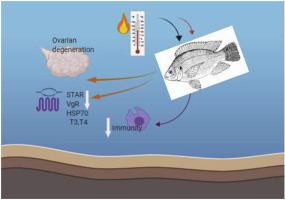当前位置:
X-MOL 学术
›
J. Therm. Biol.
›
论文详情
Our official English website, www.x-mol.net, welcomes your
feedback! (Note: you will need to create a separate account there.)
Deleterious impacts of heat stress on steroidogenesis markers, immunity status and ovarian tissue of Nile tilapia (Oreochromis niloticus)
Journal of Thermal Biology ( IF 2.9 ) Pub Date : 2020-07-01 , DOI: 10.1016/j.jtherbio.2020.102578 Shawky Mahmoud 1 , Asmaa Sabry 1 , Ahmed Abdelaziz 1 , Mustafa Shukry 1
Journal of Thermal Biology ( IF 2.9 ) Pub Date : 2020-07-01 , DOI: 10.1016/j.jtherbio.2020.102578 Shawky Mahmoud 1 , Asmaa Sabry 1 , Ahmed Abdelaziz 1 , Mustafa Shukry 1
Affiliation

|
The water temperature of aquacultures is a primary factor of fish welfare, reproductive patterns, and immunity. To elucidate the molecular and biological processes of the temperature modulation of reproduction and immunity, female Nile tilapia (190 ± 10g) were allocated into five groups following acclimatization (150 females, three replicates, each n = 10). Each group was subjected to various temperatures (28 °C, 30 °C, 32 °C, 34 °C, and 37 °C), the group at 28 °C representing the control. Their serum levels of estradiol, cortisol, and vitellogenin were measured as well as serum triiodothyronine (T3) hormone, thyroxine (T4) hormone, and non-specific immunity (phagocytic and lysozyme activity). In addition, steroidogenic acute regulatory protein (STAR), vitellogenin gene receptor, and heat shock protein 70 (HSP70) gene expression were evaluated. The serum levels of estradiol, cortisol, and vitellogenin markedly declined (P < 0.05) in fish group at higher temperatures. In addition to T3, T4 was significantly affected (P < 0.05) in the control group. The expressions of the STAR gene (steroidogenesis) and vitellogenin receptors were also considerably down-regulated. The histopathological photomicrograph of fish subjected to high water temperature revealed injuries in ovary tissues, demonstrating its harmful effects. The experimental results verified the possible role of water temperature as a main stressor on Nile tilapia' physiology through modulation of steroidogenesis-related gene expression and immunity.
中文翻译:

热应激对尼罗罗非鱼(Oreochromis niloticus)类固醇生成标志物、免疫状态和卵巢组织的有害影响
水产养殖的水温是鱼类福利、繁殖模式和免疫力的主要因素。为了阐明生殖和免疫温度调节的分子和生物学过程,驯化后将雌性尼罗罗非鱼 (190 ± 10g) 分为五组(150 只雌性,三个重复,每组 n = 10)。每组经受不同的温度(28°C、30°C、32°C、34°C和37°C),28°C的组代表对照。测量了她们的雌二醇、皮质醇和卵黄蛋白原的血清水平以及血清三碘甲状腺原氨酸 (T3) 激素、甲状腺素 (T4) 激素和非特异性免疫(吞噬细胞和溶菌酶活性)。此外,还评估了类固醇生成急性调节蛋白 (STAR)、卵黄蛋白原基因受体和热休克蛋白 70 (HSP70) 基因表达。较高温度下鱼组雌二醇、皮质醇和卵黄蛋白原的血清水平显着下降(P < 0.05)。除了 T3,T4 在对照组中也受到显着影响(P < 0.05)。STAR 基因(类固醇生成)和卵黄蛋白原受体的表达也显着下调。遭受高水温的鱼的组织病理学显微照片显示卵巢组织受伤,表明其有害影响。实验结果证实了水温可能通过调节类固醇生成相关基因的表达和免疫,作为尼罗罗非鱼生理的主要压力源发挥作用。对照组的 T4 受到显着影响(P < 0.05)。STAR 基因(类固醇生成)和卵黄蛋白原受体的表达也显着下调。遭受高水温的鱼的组织病理学显微照片显示卵巢组织受伤,表明其有害影响。实验结果证实了水温可能通过调节类固醇生成相关基因的表达和免疫,作为尼罗罗非鱼生理的主要压力源发挥作用。对照组的 T4 受到显着影响(P < 0.05)。STAR 基因(类固醇生成)和卵黄蛋白原受体的表达也显着下调。遭受高水温的鱼的组织病理学显微照片显示卵巢组织受伤,表明其有害影响。实验结果证实了水温可能通过调节类固醇生成相关基因的表达和免疫,作为尼罗罗非鱼生理的主要压力源发挥作用。
更新日期:2020-07-01
中文翻译:

热应激对尼罗罗非鱼(Oreochromis niloticus)类固醇生成标志物、免疫状态和卵巢组织的有害影响
水产养殖的水温是鱼类福利、繁殖模式和免疫力的主要因素。为了阐明生殖和免疫温度调节的分子和生物学过程,驯化后将雌性尼罗罗非鱼 (190 ± 10g) 分为五组(150 只雌性,三个重复,每组 n = 10)。每组经受不同的温度(28°C、30°C、32°C、34°C和37°C),28°C的组代表对照。测量了她们的雌二醇、皮质醇和卵黄蛋白原的血清水平以及血清三碘甲状腺原氨酸 (T3) 激素、甲状腺素 (T4) 激素和非特异性免疫(吞噬细胞和溶菌酶活性)。此外,还评估了类固醇生成急性调节蛋白 (STAR)、卵黄蛋白原基因受体和热休克蛋白 70 (HSP70) 基因表达。较高温度下鱼组雌二醇、皮质醇和卵黄蛋白原的血清水平显着下降(P < 0.05)。除了 T3,T4 在对照组中也受到显着影响(P < 0.05)。STAR 基因(类固醇生成)和卵黄蛋白原受体的表达也显着下调。遭受高水温的鱼的组织病理学显微照片显示卵巢组织受伤,表明其有害影响。实验结果证实了水温可能通过调节类固醇生成相关基因的表达和免疫,作为尼罗罗非鱼生理的主要压力源发挥作用。对照组的 T4 受到显着影响(P < 0.05)。STAR 基因(类固醇生成)和卵黄蛋白原受体的表达也显着下调。遭受高水温的鱼的组织病理学显微照片显示卵巢组织受伤,表明其有害影响。实验结果证实了水温可能通过调节类固醇生成相关基因的表达和免疫,作为尼罗罗非鱼生理的主要压力源发挥作用。对照组的 T4 受到显着影响(P < 0.05)。STAR 基因(类固醇生成)和卵黄蛋白原受体的表达也显着下调。遭受高水温的鱼的组织病理学显微照片显示卵巢组织受伤,表明其有害影响。实验结果证实了水温可能通过调节类固醇生成相关基因的表达和免疫,作为尼罗罗非鱼生理的主要压力源发挥作用。











































 京公网安备 11010802027423号
京公网安备 11010802027423号